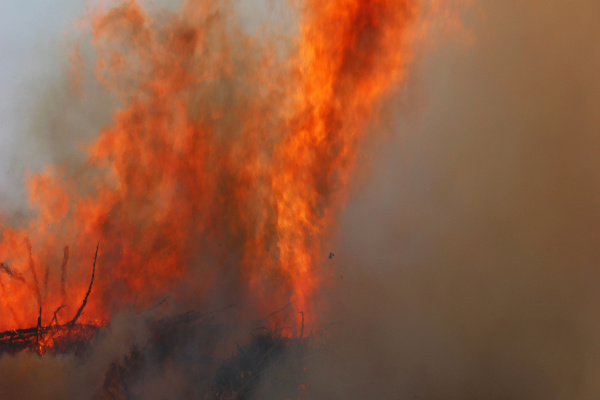Firefighters in Texas are still battling the largest wildfire in recorded state history, but they were hopeful on Monday that with cooler weather and less wind forecast for this week that they’d get an important break.
As the New York Times reports, the blaze, known as the Smokehouse Creek fire, has already scorched more than one million acres in the Texas Panhandle, making it one of the largest in U.S. history. It has devastated cattle ranches, killing thousands of cows and other animals, and it has killed at least two people as it raced across dry grasslands and consumed homes.
State fire officials said on Monday that the dry, windy conditions that had fueled the fire last week were likely to lessen in the coming days, potentially offering a reprieve to exhausted firefighters. The firefighters are stretched across five active wildfires with a combined acreage of more than 1.2 million acres, according to the Texas A&M Forest Service.
The Smokehouse Creek fire was ignited on Feb. 26, and it is not yet clear what started it. It spread around the town of Canadian, a cattle-country community of about 2,200 people northeast of Amarillo, near the Oklahoma border. Within a couple of days, the fire had spread across vast swaths of ranch lands in the Panhandle.
Some landowners have claimed that a downed electric pole had started the fire, and at least one has filed a lawsuit against an electric utility saying so, but state officials have not made any conclusions.
The fire has been burning across a sparsely populated area of Texas that is home to most of the state’s cattle: millions of cows, calves, steers and bulls. Its sprawling ranches are not always easily traversable by road. Wildfires are nothing new for Panhandle ranchers, many of whom know how to transform their pickups into makeshift fire trucks to fight a blaze. But the scale of this fire is something these Texans haven’t seen in their lifetimes.
In addition to the ranchers, residents of the small communities that dot the landscape, like Fritch and Canadian, have seen their homes, cars and churches reduced to rubble. Gov. Greg Abbott said on Friday that early assessments suggested that about 400 to 500 structures in the region had been destroyed by the fire, and he cautioned that the number could rise as surveys continued. Officials also said that several firefighters and other emergency workers had been injured.
Two deaths have been connected to the fires so far. Joyce Blankenship, an 83-year-old woman living on the outskirts of Stinnett, perished in her home when flames overtook her property on Feb. 27. Cindy Owen, 44, died from burns after flames surrounded her company truck the same day as she drove home to Amarillo from Oklahoma. She later died at a hospital.
The Smokehouse Creek fire was 15 percent contained as of Monday afternoon, the authorities said. The rugged terrain of the Canadian River Valley, where the fire started, has been a major obstacle for firefighters because fire trucks cannot navigate some of the area’s cliffs, valleys and steep hills.
Rain helped to stall the fire’s growth last week, but warm, windy and dry weather returned over the weekend, and a new fire burned about 300 acres next to Lake Meredith, about 40 miles north of Amarillo, before firefighters put it out.
On Monday, firefighters were checking for hot spots in places the fire had set ablaze, trying to ensure that it did not flare up again. Even as fire officials were optimistic about the prospect of improved conditions this week, the National Weather Service said portions of the Panhandle remained under “elevated” risk of a fire.
In most of Texas, wildfires happen in the summer. But in the Panhandle, the fire risk is highest around March, when temperatures rise, strong winds blow over the flat landscape and dry grass can easily catch fire.
Climate change is most likely making fire season start earlier and last longer by increasing the number of days in a year with hot and dry weather conditions that enable wildfires, said John Nielsen-Gammon, the Texas state climatologist and a professor of atmospheric science at Texas A&M University. Temperatures in Texas have risen by 0.61 degrees Fahrenheit per decade since 1975, according to a 2021 report by the state climatologist’s office. The relative humidity in the Panhandle region has been decreasing as well.
—
Photo Credit: RobertFord / Shutterstock.com
